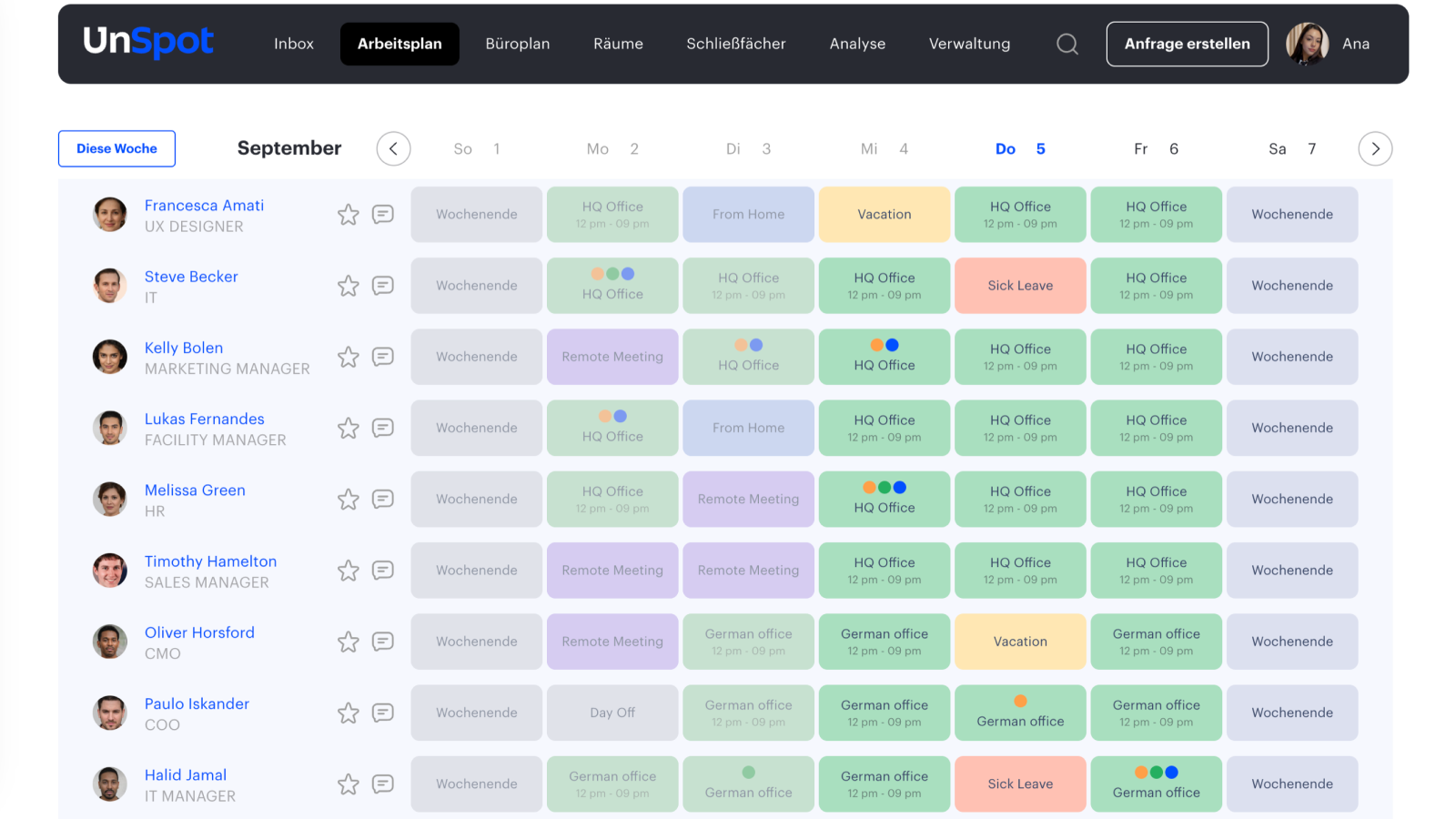Bei einem Büroumzug müssen Unternehmensleiter viele Aufgaben koordinieren und gleichzeitig managen. Dazu gehört nicht nur der Umzug der Mitarbeiter, sondern auch der Umzug von Möbeln, Geräten, Computern und allem anderen, was das Unternehmen benötigt. In diesem Artikel finden Sie eine Checkliste für den Büroumzug sowie einige praktische Tipps und Tricks, die Ihnen bei der Bewältigung der Herausforderungen helfen.
6 Aspekte, die Sie bei der Planung des Firmenumzugs berücksichtigen sollten
Vielleicht haben Sie bereits den idealen Standort für den Umzug gefunden. Doch bevor wir zur Checkliste für den Büroumzug übergehen, gibt es zunächst ein paar Dinge, die Sie in den Griff bekommen müssen.
1. Zeitrahmen festlegen
Es ist wichtig zu wissen, wie viel Zeit Sie für den Umzug von Möbeln und anderen Gegenständen benötigen, wenn Sie in ein Büro umziehen. Ein realistischer Zeitplan stellt sicher, dass Ihre Abteilungen den Ball am Laufen halten können. Prüfen Sie, ob Ihr Umzugstermin mit wichtigen Feiertagen wie Weihnachten oder dem Firmenjubiläum kollidiert. Sollte dies der Fall sein, ist es ratsam, den Termin zu verschieben, da große Feiertage zusätzliche Vorbereitungen und ein höheres Budget erfordern und ein Teil des Personals mit anderen Aufgaben belastet sein könnte.
2. Budget planen
Stellen Sie sicher, dass der Umzug in das Budget des Unternehmens passt. Sie können recherchieren oder enge Partner fragen, was andere für einen Umzug ähnlicher Größe und Umfangs bezahlt haben.

Firmenumzug Checkliste: Budgetplanung für Ihren Büroumzug:
- Mietkosten für ein neues Büro
- Unterlagen für einen Umzug
- Designprojekt
- Renovierung der Räumlichkeiten
- Trennwände, Möbel, Dekoration
- Navigation und Branding
- Packen der Gegenstände am bisherigen Standort
- Transport
- Verbrauchsmaterialien für die Einrichtung des neuen Büros
3. Packplan erstellen
Achten Sie auf die Beschriftung und Verpackung, insbesondere wenn es um IT und Technologien geht. In der folgenden Tabelle finden Sie einige Richtlinien für die Checkliste zum Checkliste für die Verpackung

Etiketten helfen bei der Organisation und minimieren das Risiko, dass etwas verloren geht. Außerdem beschleunigen sie das Auspacken nach dem Umzug.
Betrachten Sie den Umzug auch als Gelegenheit, alle unnötigen Gegenstände und Akten auszumisten und zu entfernen, die nur Unordnung verursachen. Es kann durchaus sein, dass Sie einige davon vor Jahren abgelegt und vergessen haben. Folgendes können Sie tun:
- Entfernen Sie alte Dateien, die nicht mehr benötigt werden
- Unnötige Papiere vernichten
- Entsorgen Sie alte Möbel oder spenden Sie sie an Bedürftige.
4. Arbeitsabläufe während des Umzugs sicherstellen
Besonders wichtig ist es, die Auswirkungen eines Büroumzugs zu minimieren. Verwenden Sie Plattformen, die bei der Organisation der Arbeit helfen, wie die All-in-one Hybrid Office Platform . Sie wird sich als praktisch erweisen, da eine interaktive Karte dabei hilft, sich an einem unbekannten Ort zu orientieren. Mitarbeiter können Küche, Toiletten und Besprechungsräume leicht finden. Sie müssen nicht fragen, wo sich der Arbeitsplatz Ihres Kollegen befindet – sie schauen auf den Plan und finden die Antwort.
Während der Umstrukturierungen könnten Sie Homeoffice anbieten, um eine angenehme Arbeitsatmosphäre zu schaffen. Jedoch sollten klare Richtlinien für das Homeoffice aufgestellt werden, um den Ablauf zu steuern.
5. Kommunikation mit den Mitarbeitern sicherstellen
Es ist wichtig, eine durchdachte Kommunikation aufzubauen. Erklären Sie die Gründe für den Umzug, heben Sie die Vorteile hervor und stellen Sie sicher, dass sie für den nächsten Schritt bereit sind.
Am besten befragen Sie Ihre Mitarbeiter zu ihren Vorlieben in Bezug auf Platz und Arbeit im Allgemeinen. Die Mitarbeiter werden Ihre Idee eines Büroumzugs gerne unterstützen, wenn Sie ihren Sonderwünschen hinsichtlich Dingen wie Privatsphäre, Besprechungsräumen oder Nähe zu anderen Personen oder Abteilungen nachkommen.
6. Den neuen Standort auf Mängel prüfen
Alle Schritte sind vergeblich, wenn Sie die Überprüfung eines Standorts vernachlässigen. Bedenken Sie, dass einige Probleme nicht sofort erkennbar sind.
Hier finden Sie eine Checkliste für die Überprüfung des neuen Büros, um sicherzustellen, dass es alle Anforderungen erfüllt.
- Verfügt ein neuer Standort über eine gute Infrastruktur?
- Was war vorher an diesem Ort? Wie lange ist das Büro ungenutzt?
- Gibt es Probleme mit Strom, Internetanschluss, Wasserversorgung und Lüftung?
- Gibt es im neuen Büro noch Dinge, die vor dem Umzug verbessert werden müssen? Benötigt der Raum zusätzliche Zeit für Renovierungen?
Der nächste Schritt besteht darin, eine Checkliste für die Planung Ihres Büroumzugs zu erstellen und diese während der gesamten Zeit zu befolgen.
Checkliste für den Büroumzug: 16 wichtige Schritte, die Sie befolgen sollten
Um sicherzustellen, dass alles gut läuft, legen Sie Fristen fest, die wichtige Daten und Zwecke abdecken. Am besten beginnen Sie 7 bis 12 Monate im Voraus mit der Umzugsplanung. Wenn Renovierungen auf der Liste stehen, planen Sie zusätzlich 4 bis 9 Monate ein. Hier ist eine Checkliste für ein neues Büro.
Firmenumzug planen: 7–12 Monate im Voraus
1. Legen Sie das Budget für den Umzug fest. Bereiten Sie einen Kostenvoranschlag für den Büroumzug vor. Es ist besser, damit zu rechnen, dass das Budget überschritten wird.
2. Engagieren Sie einen Projektmanager, der den Umzug überwacht. Dies ist einer der wichtigsten Punkte auf der Checkliste für den Büroumzug, obwohl Geschäftsinhaber die Delegation von Aufgaben oft vernachlässigen. Aber der Umzug ist vergleichbar mit einem großen Geschäftsprojekt, bei dem Sie einen Teamleiter brauchen, der eine wichtige Aufgabe unter Kontrolle hat. Finden Sie einen verantwortungsbewussten, detailorientierten Mitarbeiter, der die Initiative ergreifen kann und in der Lage ist, diesem Projekt Vorrang vor dem Rest seiner Arbeit einzuräumen.
3. Wählen Sie ein Umzugsunternehmen. Fragen Sie unbedingt nach den angebotenen Leistungen und geben Sie an, ob das Anheben und Auspacken der Umzugsgüter inbegriffen ist. Stellen Sie sicher, dass das von Ihnen gewählte Unternehmen zertifiziert und versichert ist.
Bei einem Umzugsunternehmen sollte man nicht sparen
Lassen Sie sich nicht von niedrigen Preisen täuschen. Harte, mühsame Arbeit darf nicht unterschätzt werden. Wenn der Preis zu niedrig ist, ist das Team möglicherweise unerfahren oder dem Fahrer fehlen Fähigkeiten und Ortskenntnisse oder der Lader hält sich nicht an die Vorschriften für den Warentransport.
Büroumzug Checkliste: 4–6 Monate im Voraus
4. Informieren Sie Ihre Mitarbeiter über den Umzug. Versorgen Sie sie außerdem regelmäßig mit Updates und erstellen Sie eine Checkliste für den Büroumzug, die Sie an Ihre Mitarbeiter verteilen.

5. Kaufen Sie Möbel und Ausrüstung und aktualisieren Sie die Informationen. Prüfen Sie, ob die alten Möbel verwendet werden können, und vergessen Sie nicht, Maße für den zukünftigen Standort zu nehmen. Geben Sie auch die Aufgabe, die Unternehmenswebsite und Markierungen auf Karten zu bearbeiten.
1–3 Monate im Voraus
6. Packen Sie unwichtige Gegenstände ein. Das sind Dinge, die die Arbeit nicht aufhalten, wie Bücher in der Bibliothek oder Brettspiele. Kreuzen Sie sie auf einer Checkliste für den Umzug an.
7. Termin festlegen und weitere Personen informieren. Informieren Sie Lieferanten, Kunden und Geschäftspartner und aktualisieren Sie Ihre Kontaktdaten. Sie können eine E-Mail senden und darin eine neue Adresse und das Datum angeben, ab dem Sie dort zu finden sind.
8. Planen Sie eine erneute Besichtigung vor Ort ein. Prüfen Sie, ob das Umzugsunternehmen alles rechtzeitig transportieren kann.
9. Richten Sie eine Büroplattform ein. Wenn Sie bisher noch keine verwendet haben, ist dies ein Schritt nach vorne, um Ihr Management zu verbessern und die Anpassung zu erleichtern. Sie können einen Büroplan erstellen, der den Arbeitsplatz und das Büro-Layout aller Mitarbeiter zeigt.
Büroumzug - was zu beachten ist: 1–3 Wochen im Voraus
10. Packen Sie die restlichen Gegenstände ein. Beschriften Sie die Kartons mit Inhaber, Zielort und Inhalt. Bereiten Sie auch die alten Standorte für die Kontrolle durch den Vermieter vor.
11. Kontaktieren Sie das Umzugsunternehmen. Informieren Sie sich, dass alles nach Plan läuft. Stellen Sie sicher, dass das Unternehmen keine Fristen versäumt und bereit ist, die Verpflichtungen zu erfüllen.
12. Helfen Sie Ihren Mitarbeitern, effizient zu arbeiten. Vermeiden Sie eine Überlastung durch zu viele Aufgaben und geben Sie ihnen die Möglichkeit, von zu Hause aus zu arbeiten.

Umzugstag
13. Kontrollieren und überwachen Sie den Umzug. Achten Sie darauf, dass die Sachen sorgfältig verladen werden und nichts vergessen werden.
14. Helfen Sie den Mitarbeitern bei der Anpassung. Wenn Sie einige Zeit lang von zu Hause aus gearbeitet haben, bieten Rückkehrhilfen eine sichere Rückkehr ins Büro und unterstützen eine langfristige, flexible Arbeitsplatzstrategie. Im Folgenden finden Sie einige Fähigkeiten:
- Arbeitsplätze mit interaktiven Karten kurz- oder langfristig buchen;
- Buchungs- und Check-in-Daten zur Kontaktverfolgung nutzen;
- Sammeln Sie genaue Daten, ohne externe Berater einzustellen oder Ihre Mitarbeiter zu befragen.
Nach dem Umzug
15. Erledigen Sie den Rest der Arbeit. Packen Sie Möbel oder Geräte aus und ordnen Sie sie an. Überprüfen Sie, ob es Bereiche gibt, die verbessert werden müssen. Überprüfen Sie, ob die Adresse überall geändert wurde:
- auf Visitenkarten
- Webseite
- in sozialen Netzwerken
16. Feiern Sie den Erfolg mit Ihren Mitarbeitern. Wenn alle Schritte der Checkliste für den Büroumzug erledigt sind, feiern Sie den Anlass, der zur Teambildung beiträgt. Sie können ihn im Büro abhalten, damit sich die Mitarbeiter an den neuen Ort gewöhnen.

Firmenumzug - was ist zu beachten, wenn sich der Umzug verzögert?
Manchmal ist es schwierig, alle Probleme zu überblicken, selbst wenn Sie eine Checkliste für den Umzug eines Unternehmens befolgen. Der Umzug kann sich verzögern. Besonders schwierig ist es in einer Situation, in der die bisherigen Räumlichkeiten vermietet und alles eingepackt ist, aber kein Umzug in die neuen Räumlichkeiten möglich ist. Halten Sie sich dann an die folgenden Tipps.
1. Überlegen Sie, wie Sie während des Umzugs arbeiten können. Wenn das Budget es zulässt, können Sie die Arbeit in einem Coworking-Center organisieren. Dann müssen Sie die Kosten decken. Eine weitere Möglichkeit ist, für einige Zeit von zu Hause aus zu arbeiten.
2. Informieren Sie die Mitarbeiter und legen Sie einen neuen Umzugstag fest. Prüfen Sie, ob die Information alle erreicht.
3. Wenn Sie Mitarbeiter einstellen, erklären Sie die Situation. Möglicherweise ist es besser, die Einstellung neuer Mitarbeiter während des Umzugs zu verschieben, da ihre Einarbeitung gestört wird.
Einige Lifehacks: Umzug eines Büros
Die folgenden Tipps helfen Ihnen dabei, Ihr Firmenbüro schnell und sicher umzuziehen, ohne unnötige Kosten zu verursachen.
1. Planen Sie den Umzug am Wochenende, um Arbeitsunterbrechungen zu vermeiden.
2. Implementieren Sie das Büroverwaltungssystem , das die Buchung von Arbeitsplätzen, Konferenzräumen, Schließfächern und Parkplätzen erleichtert.
3. Beauftragen Sie für große Büros zwei Umzugskoordinatoren: einen für den alten und einen für den neuen Standort.
4. Verschieben Sie Dokumente einzeln. Weisen Sie diese Aufgabe einem Mitarbeiter zu.
5. Richten Sie einen Chatroom ein, um die Mitarbeiter über den Umzug auf dem Laufenden zu halten.
6. Unterschreiben Sie nicht vorschnell Blanko-Auftragsformulare oder Verträge mit dem Umzugsunternehmen.
7. Bleiben Sie mit dem Umzugsunternehmen in Kontakt. Wenn Sie mit der Gefahr konfrontiert werden, ignoriert zu werden, suchen Sie so schnell wie möglich ein neues Unternehmen.
Ein Umzug ist nicht so mühsam, wie er zunächst klingt. Wenn Sie alle Tipps – von der Fallplanung bis zur Erfolgsfeier – beachten, gelingt Ihnen der Umzug in Ihren neuen Arbeitsplatz reibungslos.
Lange Rede, kurzer Sinn
- Beginnen Sie am besten schon frühzeitig mit der Planung eines Büroumzugs – für die Betriebsverlagerung benötigen Sie mindestens ein halbes Jahr.
- Berechnen Sie Ihr Budget für den Umzug, aber rechnen Sie mit zusätzlichen Kosten.
- Überprüfen Sie das neue Layout gründlich, bevor Sie einziehen.
- Delegieren Sie Aufgaben an andere: Wenn der Eigentümer eines Unternehmens zu sehr mit dem Umzugsprozess und der Planung beschäftigt ist, verliert das Unternehmen seinen Leiter.
- Machen Sie den Umzug an einen neuen Standort mit einer modernen Lösung komfortabler: Implementieren Sie einen Büroplan und einen Internal Help Desk, der die Eingewöhnung an einen neuen Standort beschleunigt.
- Nutzen Sie unsere Checkliste für den Firmenumzug, um beim Auszug nichts zu vergessen.







